Second Wind: City of Steam: Arkadia
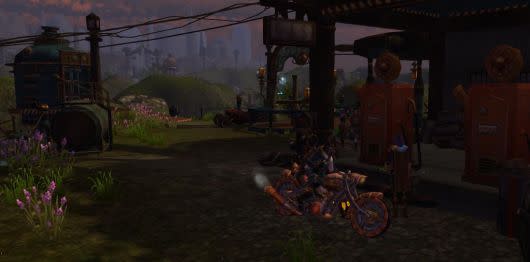
I've been rooting for City of Steam ever since it was first announced, mostly due to my sheer love of the steampunk genre. We've got high fantasy and gritty sci-fi games galore, but steampunk has been largely neglected in the realm of gaming.
That's why it was so disheartening to hear that City of Steam's first incarnation (of which I spoke rather highly when I saw it at PAX East in early 2013) would be shutting down after only about five months of opening its doors to players. It was a bold move for Mechanist Games to make the jump to self-publishing, and when I saw the game featured on Kongregate, I decided I'd check and see how the troubled title was holding up in its new form. The question is, does City of Steam: Arkadia manage to stoke the fires or is it just a bunch of hot air?
Turns out that it's a bit of both, really. Everything that I praised in my original hands-on with the game at PAX East 2013 still applies in the current version of the game. It looks great, especially considering it runs in the confines of a web browser, and the steampunk-fantasy flavor is a welcome change from your run-of-the-mill high fantasy settings that seem ubiquitous in the MMO genre.
On top of that, the game certainly has no shortage of things to do. Players can take part in some tried-and-true traditional quests, fight it out in PvP combat, run through a number of dungeons and challenges, craft and modify equipment, upgrade their vehicles, recruit and level up new companions... the list goes on and on. The sheer amount of things the game throws at you is frankly startling at times.
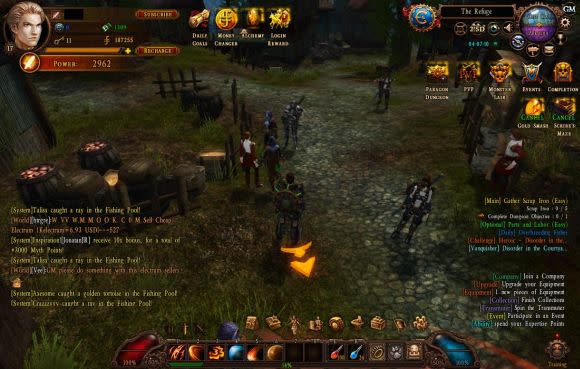
I mean, just look at that screenshot up there. See all of those flashy little buttons and icons and widgets and stuff cluttering the UI? Just about every one of those represents some kind of event taking place or some bit of content in which I can participate, and it's kind of insane. It's also worth noting that, despite all of that crazy clutter and madness going on in the interface, it's still surprisingly navigable. It certainly won't be winning any awards for tidiness, but it gets the job done.
The gameplay itself isn't anything to write home about, but it's definitely solid. It's pure action-RPG in the vein of Diablo, and that's really about all there is to say about it: standard tab-targeting, hotkey-pressing combat system, plus the continual chugging of health and mana potions when things go South. Overall, there's nothing new to see here, but there's nothing worthy of too much criticism either. The only real issues I had during my time with the game stemmed from a finnicky camera and having my vision obscured as a result.
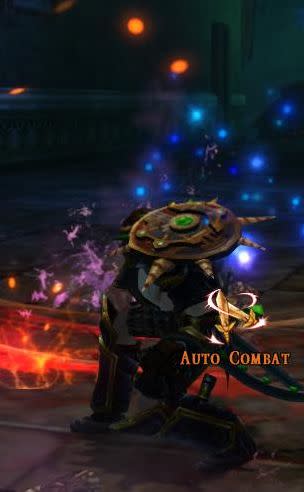
City of Steam: Arkadia also features a number of time-based and offline progression features that allow players to get things done even when they're unable to devote their full attention to the game. There are dungeons that you can simply set your character to run, and after a certain period of time has elapsed, you go and collect your rewards and experience. In addition, your character will continue to train while you're offline, accumulating experience and skill points to be collected when you next log in.
But perhaps the most unique -- and frankly, strangest -- thing about City of Steam is the fact that it can practically play itself. See, the game features the usual array of "convenience" features such as the ability to click on a quest and automatically run to that quest's objective and to click a location on your map and autorun to the chosen spot, but City of Steam takes it a bit further. Not only will clicking on a quest in your log cause your character to run to the objective's location, but it'll even go ahead and complete the job while it's at it.
Really, the only thing you need to do to progress through the game (at least the first 30-40 levels or so) is be able to click buttons. Click a button to run to the quest objective. Click it again to complete the objective. Every time you pick up a piece of gear that the game deems an upgrade, a tooltip will pop up recommending you equip the item alongside a button that does so automatically. You can even let the game automatically determine which stats to increase with your earned skill points if you don't feel like working it out for yourself.
And when I say the game will do everything for you, I really do mean everything. When you arrive at a dungeon, all you have to do is hit the X key and your character will proceed to beat the everloving daylights out of every living thing in sight and pick up all the shinies that they drop. All you have to do is make sure that your gear is up to snuff and that your stats have been distributed appropriately (and as I said, the game does that for you as well) and the game will handle the rest. Of course, it probably helps that the dungeon objectives are almost always "earn X experience, pick up Y shillings, then kill the boss." In a way, it's kind of impressive that the game can practically play itself with minimal user input, but at the same time, I kind of have to wonder what the point of it really is.
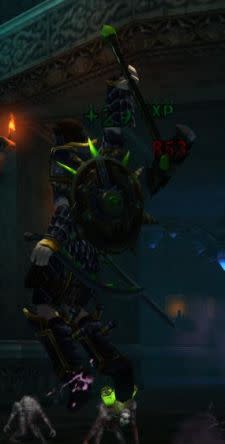
Unfortunately, my previous praise for the game's style and features isn't the only thing that remains true from my first hands-on of the game at PAX East. I also mentioned in that article that I had some misgivings about the game's cash shop, and it would appear that I had the right idea. In fact, it's kind of alarming how frequently City of Steam tries to entice you into throwing money at it. Electrum, the game's real-money currency, can be used for an insane variety of things, such as replenishing energy (which is required to enter dungeons and participating in other activities and regenerates slowly over time), bypassing certain daily goal objectives or other hurdles, speed up the progress of time-based progression, and of course, buying items from the cash shop.
The shop itself doesn't seem too particularly unbalancing at first glance. It sells the normal array of convenience items like experience boosts, crafting materials, pets (which, I was told, are astronomically rare throughout the course of normal gameplay), mounts, and cosmetic items. The weird thing, though, is that the cosmetic items... aren't. Each piece of cosmetic gear has an array of stats attached to it (which may or may not scale with level -- I wasn't able to confirm that one), and wearing a full ensemble of matching cosmetic gear grants a set bonus that includes additional stat boosts plus a bonus to experience earned. Now, I don't think that the cosmetic gear sold in the item shop is going to be competing with endgame gear anytime soon, but it still seems odd to me that supposedly "cosmetic" gear provides a mechanical benefit.
And if that isn't strange enough, wait until you hear about the game's subscription system. Now, my understanding my be incomplete, but from what I've been able to gather in-game, this is how it works. First, you buy a subscription for 795 Electrum per 30 days (that's $7.95 US), and that grants you the status of a Bronze Subscriber. Then, you can work to "upgrade" your account from Bronze to Silver and then from Silver to Gold. In order to do so, you accumulate points, and once you've gotten enough, your account level is upgraded. You need 20,000 points to go from Bronze to Silver, then another 100,000 to go from Silver to Gold.
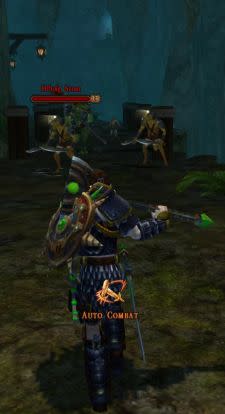
So how do you get these points? According to the in-game tooltip, you earn 200 points for each day you log in to the game, plus an additional 1 point for every Electrum you spend in game, with one Electrum being worth one cent. Now, I know plenty of games have similar programs that reward players for devoting time and money to the game, but I still can't help but feel that it's a little underhanded asking players to pay money for a subscription and then to pay more money to get the full benefits of said subscription.
All-in-all, I don't think City of Steam is a bad game, but the sheer ubiquity of microtransactions did leave something of a foul taste in my mouth. That being said, City of Steam makes an excellent time-waster and perhaps an even better idle game for those times when you just want to dabble in something on the side while you go about your daily business. It's easy to just set your character on his way and let the game run in the background. But if you're aiming to be competitive, especially in PvP, you should probably be prepared to dump a lot of time and/or money into the effort. Of course, the game's free-to-play and runs right in your browser, so if you've got a bit of time to waste, you can just check it out and see how you like it yourself. As for me, I think I'll be spending my time elsewhere.

MMOs are constantly changing, and our opinions can change with them. That's why we're here to give some beloved (or not) games a second (or third) look. Has that game that was a wreck at launch finally pulled itself together? How do the hits of yesteryear hold up today? That's what we're here to find out as Massively gets its Second Wind!

